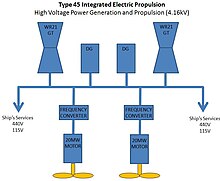Integrated electric propulsion
This article may require copy editing for grammar, style, cohesion, tone, or spelling. (March 2024) |

(GT: gas turbine; DG: diesel generator)
Integrated electric propulsion (IEP), full electric propulsion (FEP) or integrated full electric propulsion (IFEP) is an arrangement of
Some newer nuclear-powered warships also use a form of IEP. A nuclear power plant produces the steam to operate turbine generators; these in turn power electric propulsion motors.
Integrated system
| Combined marine propulsion |
|---|
|
CODOG |
Eliminating the mechanical connection between the engines and the propulsion has several advantages including increased freedom of placement of the engines,
A typical integrated electric propulsion arrangement on larger (e.g. cruise ships) and naval vessels includes both diesel generators and gas turbines. On smaller vessels (which make up the majority of IEP vessels) the engines are typically just diesel. The advantages of gas turbines include much lower weight.[1][4] and smaller size[1] than diesels of similar power, and much less noise and vibration,[4] but they are efficient only at or near maximum power. Diesel generators have the advantage of high efficiency over a wide range of power levels. Using them in combination allows for the benefits of a full range of operational efficiency, a low-vibration quiet mode of operation, and some reduction in weight and volume relative to a diesel-only arrangement. In naval vessels, a pool of diesel generators are typically used to provide a base load and enough power to achieve cruise speed. The gas turbines are used to provide peak power for higher speeds and may be required to operate weapon systems with high power demands. In passenger ships, one or more gas turbines are used for fast cruising. The diesels provide reliable redundancy and an efficient source of electricity when in port, at anchor, or drifting.
A
A
Reducing pollution
In Norway gas electric hybrid propulsion is being used on a fleet of
List of IEP ships
- US Navy)
- Type 45 destroyer (Royal Navy)
- US Navy)
- RMS Queen Mary 2 (Cunard Line)
- dry cargo ship(US Navy)
- Queen Elizabeth-class aircraft carrier (Royal Navy)
- Juan Carlos I LHD (Spanish Navy)
- Canberra-class LHD (Royal Australian Navy)
- Shirase (Japan Maritime Self-Defense Force)
- Nichinan-class oceanographic survey ship (Japan Maritime Self Defence Force)
- Shounan-class oceanographic survey ship (Japan Maritime Self Defence Force)
- Leeuwin-class Hydrographic Ship (Royal Australian Navy)
- Type 076 landing helicopter dock (People's Liberation Army Navy)
- INS Anvesh (A41) (Indian Navy & Defence Research and Development Organisation)
- Project 18 class destroyers (Indian Navy)[8]
See also
References
- ^ a b c d Dr. Timothy J. McCoy and Dr. John V. Amy Jr. "The State-of-the-Art of Integrated Electric Power and Propulsion Systems and Technologies on Ships" (PDF). American Society of Naval Engineers. Archived from the original (PDF) on July 18, 2014. Retrieved 2012-09-10.
- ^ a b [1] [dead link]
- ^ a b "The Benefits of Gas-Turbine Engines". Yachting Magazine. 2011-01-25. Retrieved 2012-09-10. [dead link]
- ^ "Pining for cleaner air in the Norwegian fjords". BBC. 4 April 2017.
- ^ "Torghatten Nord has chosen Multi Maritime design". Multi Maritime. Archived from the original on 26 February 2018. Retrieved 4 April 2017.
- ^ Brakstad, Thomas (8 November 2018). "El-ferja Ampere har no køyrd tilsvarande seks gonger rundt jorda {Six times around the world}". NRK (in Norwegian Nynorsk). Retrieved 28 March 2019.
- ^ "India, UK closer to pact on electric propulsion system for warships". The Indian Express. 2024-04-29. Retrieved 2024-04-29.
